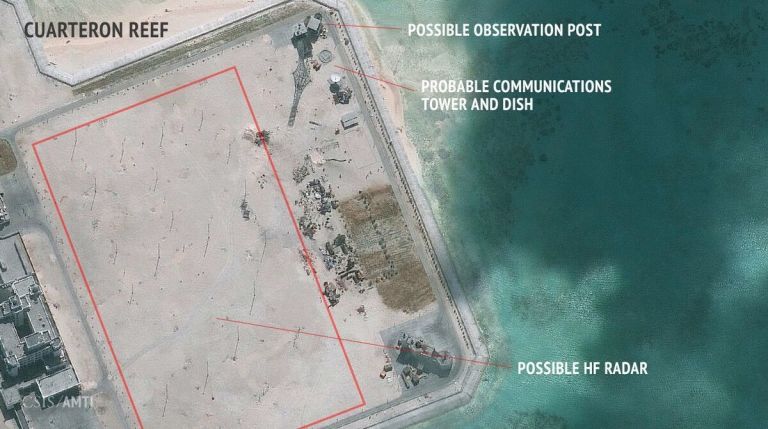By Kyle Mizokami
Source : Popular Mechanics
China appears to be building an anti-stealth radar system on an artificial island in the middle of the South China Sea, where a military-grade system would be useful in detecting stealth aircraft in the contentious and contested area.
Satellite imagery obtained by the Center for Strategic and International Studies’ Asian Maritime Transparency Initiative and DigitalGlobe (which provided the images above and below) shows the Cuateron Reef recently enlarged by dredging and now measuring about 52 acres. Beijing didn’t stop there.
The imagery also shows that China has built or is building two radar towers, a lighthouse, a communications tower, bunker, and quay for the docking of supply ships. The most interesting development is a large field covered with evenly spaced 20 meter poles. This is the kind of thing you’d need for over-the-horizon high-frequency radar systems, which can detect objects at up to 3,000 kilometers (1,864 miles), including stealth aircraft.
While HF radars can spot stealth planes, they cannot guide missiles to targets—for now. Even so, the radars are useful in providing an early warning network, cueing Chinese fighter planes such as the J-11—also based on an artificial island in the South China Sea—to the probable location of stealth aircraft.
The position of the radar would be ideal for detecting American and allied aircraft operating from bases in the Philippines. The Philippines, embroiled in a dispute with China over the Scarborough and Second Thomas shoals—has made its air and naval facilities available to the United States.
In recent years, China has laid claim to 90 percent of the South China Sea. While many countries claim part of the South China Sea, none have claimed—and seized—as much as China. To support its claim, China has taken several shoals and reefs and expanded them dramatically with sand dredged from the sea floor.
China believes (or at least claims) that this bit of terraforming amounts to a legal transformation of these shoals from nuisance navigational hazards to full sovereign territory, complete with a12-mile territorial boundary and a 200 mile exclusive right to economic development.
The radar site, first noticed in 2015, became particularly newsworthy after last week’s announcement that China had deployed HQ-9 long-range surface-to-air missiles on another artificial island in the South China Sea. Although the two systems are too far apart to support one another, together they do support the argument that China is fortifying the South China Sea.

